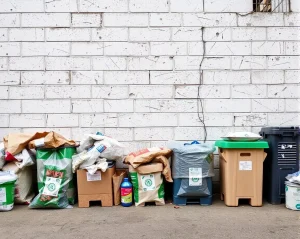¿Cómo ayudan los envases sostenibles al medio ambiente?
Menú Contenido
● The Indispensable Nature of Packaging
● The Environmental Footprint of Packaging
● The Rise of Sustainable Packaging: A Paradigm Shift
● Types of Sustainable Packaging Materials:
● Challenges and Opportunities
● Conclusion: Embracing Sustainability for a Greener Future
The world we live in is a world of packaging. Almost everything we buy is wrapped, boxed, or contained in some form from the smallest trinket to the largest appliance. Packaging serves vital roles in product protection, information dissemination, and consumer convenience. However, the environmental impact of packaging has become a pressing concern, prompting a shift towards sustainable practices. This article delves into the multifaceted role of packaging, and its environmental impact, and explores the crucial ways sustainable packaging can contribute to a greener future.
The Indispensable Nature of Packaging
Packaging isn’t just an added layer; it’s a critical component of the modern supply chain, playing a diverse range of roles:
- Product Protection: Packaging acts as a shield, safeguarding products from damage during transportation, handling, and storage. This ensures product integrity, minimizes waste and guarantees consumer satisfaction.
- Information Dissemination: Packaging serves as a platform for product information, conveying ingredients, instructions, warnings, and branding. Clear and concise packaging enhances consumer understanding and promotes informed purchasing decisions.
- Consumer Convenience: Packaging facilitates ease of use, making products accessible and manageable. It enables convenient storage, portioning, and disposal, contributing to a streamlined consumer experience.
- Marketing and Branding: Packaging is a powerful marketing tool. Attractive designs, colors, and materials can influence consumer perception, convey brand identity, and create a memorable customer experience.

The Environmental Footprint of Packaging
Despite its undeniable utility, packaging carries a substantial environmental burden. The production, transportation, and disposal of packaging materials contribute to a range of environmental issues:
- Resource Depletion: The manufacturing of packaging materials requires vast quantities of natural resources, including wood, fossil fuels, and minerals. This depletion can lead to deforestation, habitat loss, and pollution.
- Greenhouse Gas Emissions: The production and transportation of packaging contribute to greenhouse gas emissions, exacerbating climate change. The use of non-renewable energy sources and the release of volatile organic compounds contribute to this environmental impact.
- Landfill Waste: A significant portion of packaging ends up in landfills, where it decomposes slowly, taking up valuable space and releasing harmful chemicals into the environment.
- Pollution: The production and disposal of certain packaging materials, such as plastics and chemicals, can contaminate air, water, and soil, posing threats to human health and ecosystem stability.

The Rise of Sustainable Packaging: A Paradigm Shift
The recognition of packaging’s environmental impact has spurred a movement towards sustainable practices. Sustainable packaging prioritizes environmental responsibility throughout its lifecycle, from sourcing raw materials to disposal.How Does Sustainable Packaging Help the Environment?Envases sostenibles addresses the environmental concerns associated with traditional packaging by:
- Using Renewable Resources: Prioritizing materials derived from sustainable sources, such as plant-based polymers, recycled paper, and compostable materials, reduces reliance on non-renewable resources.
- Reducing Waste: Employing designs that minimize material usage, incorporate reusable elements, or promote easy recycling or composting contributes to a circular economy.
- Minimizing Emissions: Choosing low-carbon manufacturing processes, optimizing transportation routes, and utilizing renewable energy sources help reduce the carbon footprint of packaging.
- Biodegradability and Compostability: Selecting materials that biodegrade or compost in a controlled environment reduces landfill waste and promotes soil enrichment.
- Recyclability: Utilizing materials that can be easily recycled, with clear labeling and design features that promote proper sorting, encourages resource recovery and reduces reliance on virgin materials.

Types of Sustainable Packaging Materials:
- Paper and Cardboard: Made from renewable resources, readily recyclable, and often compostable, paper and cardboard are staples in sustainable packaging.
- Bioplastics: Derived from renewable sources like corn starch or sugarcane, bioplastics offer an alternative to traditional petroleum-based plastics with improved biodegradability and compostability.
- Glass: A highly recyclable material, glass is durable and often used for food and beverage packaging, contributing to a circular economy.
- Aluminium: Highly recyclable and durable, aluminium is often used for beverage cans and other applications, offering long-term reusability and environmental benefits.
- Compostable Plastics: Made from biodegradable materials like cornstarch, these plastics decompose in controlled environments, enriching soil and reducing landfill waste.

Challenges and Opportunities
The transition to sustainable packaging faces challenges:
- Cost: Sustainable packaging materials can be more expensive to produce than traditional materials, potentially leading to higher product prices.
- Infrastructure: A lack of comprehensive recycling and composting infrastructure in certain regions can hinder the effective implementation of sustainable packaging solutions.
- Consumer Education: Raising consumer awareness about sustainable packaging options and encouraging proper disposal practices is crucial for maximizing environmental benefits.
However, opportunities abound:
- Technological Advancements: Innovations in material science and manufacturing processes are driving the development of more sustainable packaging solutions.
- Government Regulations: Governments are implementing policies and regulations that incentivize sustainable packaging practices and reduce the environmental impact of traditional materials.
- Consumer Demand: Increasing consumer awareness and demand for environmentally responsible products are pushing businesses to prioritize sustainable packaging options.
Conclusion: Embracing Sustainability for a Greener Future
Sustainable packaging is not just a trend; it’s a necessity. By choosing environmentally responsible packaging options, businesses and consumers can contribute to a greener future, reducing our reliance on finite resources, mitigating climate change, and minimizing waste. The transition to sustainable packaging requires collaboration, innovation, and a shared commitment to environmental stewardship. Together, we can create a world where packaging plays a positive role in our lives and our planet’s well-being.
